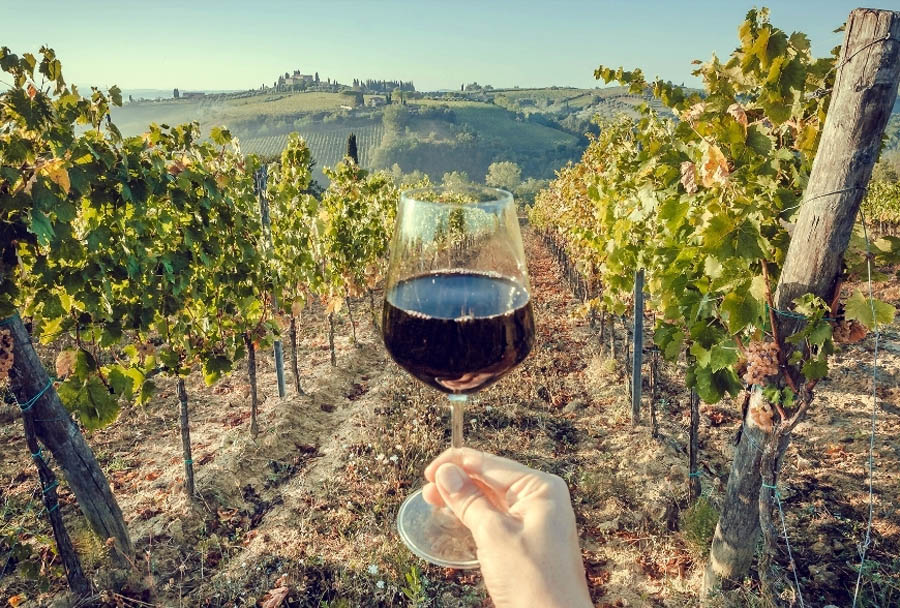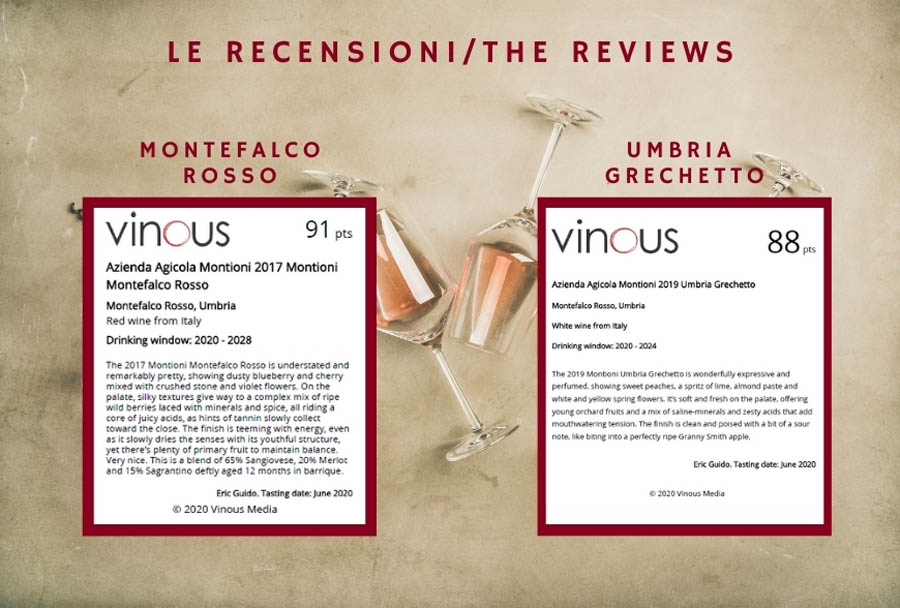The prestigious international publication Vinous gives great scores to two particular Montioni branded wine productions
The Italian editor for Vinous Eric Guido, evaluated Montefalco Rosso with a score of 91 and Umbria Grechetto with 88: two fantastic scores for the first tasting of our products by this prestigious wine publication.
At the intersection of media and technology, Vinous is Antonio Galloni’s vision of a modern-day wine publication. Vinous’s team of renowned critics and writers offers in depth coverage of new releases, retrospectives and verticals of older wines, videos with winemakers, interactive maps, restaurant recommendations and more, all published in a continual, daily stream of articles. With the acquisition of Stephen Tanzer’s International Wine Cellar in December 2014 and the addition of the IWC editorial team, Vinous expanded coverage to all major wine regions. Today Vinous has subscribers in over 100 countries and is one of the most respected wine publications in the world.



Are you curious about their reviews?
The editor of Vinous, Eric Guido, took care of the tasting of Montioni wines on June 2020.
UMBRIA GRECHETTO 2019: 88 points
Versione originale: “The 2019 Montioni Umbria Grechetto is wonderfully expressive and perfumed, showing sweet peaches, a spritz of lime, almond paste and white and yellow spring flowers. It’s soft and fresh on the palate, offering young orchard fruits and a mix of saline-minerals and zesty acids that add mouthwatering tension. The finish is clean and poised with a bit of a sour note, like biting into a perfectly ripe Granny Smith apple.”
MONTEFALCO ROSSO MONTIONI 2017: 91 points
Versione originale: “The 2017 Montioni Montefalco Rosso is understated and remarkably pretty, showing dusty blueberry and cherry mixed with crushed stone and violet fowers. On the palate, silky textures give way to a complex mix of ripe wild berries laced with minerals and spice, all riding a core of juicy acids, as hints of tannin slowly collect toward the close. The finish is teeming with energy, even as it slowly dries the senses with its youthful structure, yet there’s plenty of primary fruit to maintain balance. Very nice. This is a blend of 65% Sangiovese, 20% Merlot and 15% Sagrantino deftly aged 12 months in barrique.”

Thanks to Vinous for tasting and reviewing our wine products!
On occasion, the winemaker may decide to leave them in if the grapes themselves contain less tannin than desired. This is more acceptable if the stems have ‘ripened’ and started to turn brown. If increased skin extraction is desired, a winemaker might choose to crush the grapes after destemming.
Wine is one of the most civilized things in the world and one of the most natural things of the world that has been brought to the greatest perfection, and it offers a greater range for enjoyment and appreciation than, possibly, any other purely sensory thing.
Ernest Hemingway Tweet
Removal of stems first means no stem tannin can be extracted. In these cases the grapes pass between two rollers which squeeze the grapes enough to separate the skin and pulp, but not so much as to cause excessive shearing or tearing of the skin tissues. In some cases, notably with “delicate” red varietals such as Pinot noir or Syrah, all or part of the grapes might be left uncrushed (called “whole berry”) to encourage the retention of fruity aromas through partial carbonic maceration.
The Grapes
The quality of the grapes determines the quality of the wine more than any other factor. Grape quality is affected by variety as well as weather during the growing season, soil minerals and acidity, time of harvest, and pruning method. The combination of these effects is often referred to as the grape’s terroir.
Grapes are usually harvested from the vineyard from early September until early November in the northern hemisphere, and mid February until early March in the southern hemisphere.
In some cool areas in the southern hemisphere, for example Tasmania, harvesting extends into May. The most common species of wine grape is Vitis Vinifera, which includes nearly all varieties of European origin. The most common species of wine grape is Vitis Vinifera, which includes nearly all varieties of European origin.

Manual harvesting is the hand-picking of grape clusters from the grapevines. In the United States, some grapes are picked into one- or two-ton bins for transport back to the winery. Manual harvesting has the advantage of using knowledgeable labor to not only pick the ripe clusters but also to leave behind the clusters that are not ripe or contain bunch rot or other defects. This can be an effective first line of defense to prevent inferior quality fruit from contaminating a lot or tank of wine.
Destemming is the process of separating stems from the grapes. Depending on the winemaking procedure, this process may be undertaken before crushing with the purpose of lowering the development of tannins and vegetal flavors in the resulting wine. Single berry harvesting, as is done with some German Trockenbeerenauslese, avoids this step altogether with the grapes being individually selected.
Crushing is the process when gently squeezing the berries and breaking the skins to start to liberate the contents of the berries. Destemming is the process of removing the grapes from the rachis (the stem which holds the grapes).
In traditional and smaller-scale wine making, the harvested grapes are sometimes crushed by trampling them barefoot or by the use of inexpensive small scale crushers. These can also destem at the same time. However, in larger wineries, a mechanical crusher/destemmer is used. The decision about destemming is different for red and white wine making. Generally when making white wine the fruit is only crushed, the stems are then placed in the press with the berries. The presence of stems in the mix facilitates pressing by allowing juice to flow past flattened skins.

Katerina Monroe
@katerinam • More Posts by Katerina
Congratulations on the award, it's well deserved! You guys definitely know what you're doing. Looking forward to my next visit to the winery!
